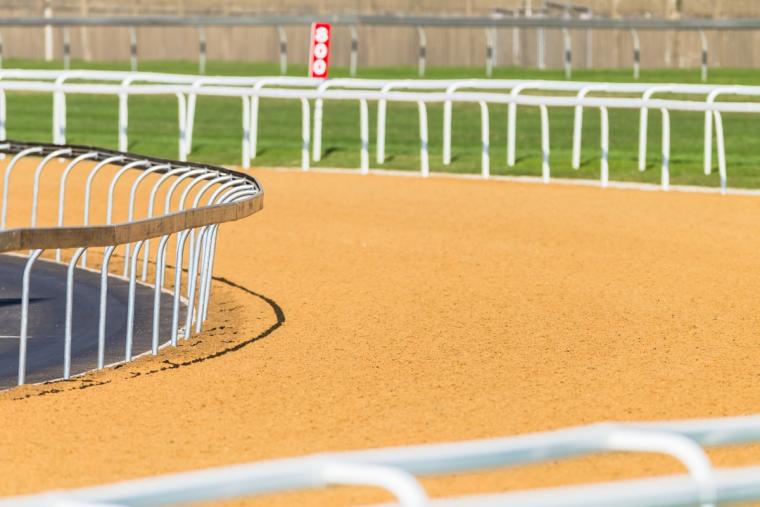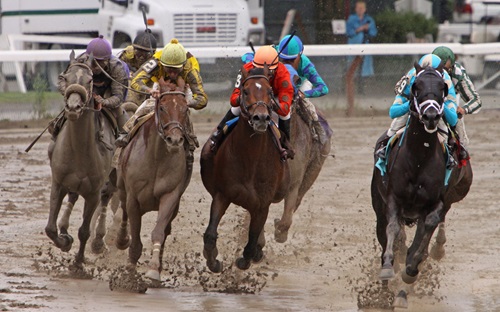
The issue of synthetic surfaces for sports is an area of continuing study. The question of whether natural grass or artificial turf is better for youth athletes is a hardy perennial when it comes to debate; however, an entirely different interest group is emerging: That of synthetic surfaces for horse racing tracks.
Before you go any further: Don’t think of it as the kind of track you’d picture for human athletes (you can see plenty of examples of these, from venues at the high school level, all the way up to the Olympics, made of rubber granules held in place with polyurethane or latex). And don’t think of it as synthetic turf either.
In horse racing terms, the classification of synthetic surfaces is meant to distinguish such tracks from natural racing surfaces like dirt and grass (confusingly referred to as turf). A synthetic track is a racing surface typically comprised of ingredients like sand, fiber, wax and rubber. Make no mistake: It’s still a granular surface, and from a distance, it looks quite a bit like a dirt track. (A picture of a synthetic track for horse racing can be found above and also here.)
Synthetic tracks have been around since the 1960s, and (not surprisingly) have been a subject of debate. Here is what has been found out so far:
Safety Data: The data for thoroughbred racing on synthetic surfaces is promising, notes the Thoroughbred Daily News (TDN), which cites data from both the California Horse Racing Board (CHRB) and the Jockey Club's Equine Injury Database (EID):
“Using both CHRB and DRF chart data, the TDN zeroed in on four California tracks: Del Mar, Santa Anita, Hollywood Park and Golden Gate Fields. Between the 2007-2008 season and the 2017-2018 season, on average 1.9 horses per 1000 starts were catastrophically injured on the synthetic tracks in place at those four facilities. That figure was 2.6 for the dirt.
 At the end of the day, “the numbers are staggering,” said the University of Kentucky's Mick Peterson, about the marked difference in race-day fatality numbers between the dirt and synthetics. But, as with most issues concerning catastrophic breakdowns, the numbers only tell part of the story.
At the end of the day, “the numbers are staggering,” said the University of Kentucky's Mick Peterson, about the marked difference in race-day fatality numbers between the dirt and synthetics. But, as with most issues concerning catastrophic breakdowns, the numbers only tell part of the story.
“I know that there are hundreds fewer horses that are breaking down in front of the crowds, because we have synthetics,” said Peterson. “But what I don't know is how many horses have had shorter careers,” he added, highlighting a common critique of synthetics: that while catastrophic injuries appear to be less on these surfaces, they cause more potentially career-threatening injuries than dirt.”
(Note: A catastrophic injury is something that ends the life of the horse, while a career-threatening injury is something like a soft-tissue injury, which, while it means the horse may no longer race, does not decrease its value as a stud animal.)
Weather Conditions: Synthetic surfaces handle rain far better than dirt tracks, say reporters at Getting Out of the Gate. That results in more races being run, rather than cancelled; an example of which occurred in Keeneland Race Track in Lexington, Kentucky:
“When a significant amount of rainfall occurs, most tracks will take races originally scheduled on the turf course and move them to the main track. When the main track is dirt, it results in many trainers removing (scratching) their horse from the race. This is because the two surfaces are very different, and many horses prefer turf over dirt.
On the other hand, synthetic surfaces tend to be more like turf than dirt, and as a result less trainers scratch their horses when a race is taken off the turf course and moved to synthetic. For example, on [a recent rainy day when races were scheduled], three races were taken off the turf course and moved to the main synthetic surface. Those three races still managed to start 7, 9 and 10 horses. I suspect that’s several more than would have run, had the races been switched to a dirt (and likely sloppy) surface.”
In 2022, Sportsmatik noted, “The usage of synthetic fibers provides greater stability and elasticity than that of existing grass or dirt surface.”
The market for synthetic racing surfaces is still evolving; at this time, only a few manufacturers make up the industry; their product names can be found here.
Economic Impact and the Fear of the Unknown: Some data points about synthetic tracks are unquantifiable. Getting Out of the Gate notes that there are pundits who claim these surfaces make it harder to handicap, thereby decreasing betting dollars and hurting the game.
Switching to Synthetics, Switching Back: An article in Bloodhorse notes, “Perhaps it's a coincidence, but Kentucky veterinary records show a recent spike in pre-race scratches at Churchill Downs, Keeneland, and Turfway Park. Turfway vets scratched 128 horses during the track's 2023 winter meet, more than twice the previous year's total.”
(Among the notable scratches was morning-line favorite Forte, who was removed from the lineup of the 2023 Kentucky Derby on the morning of the race; Bloodhorse continues, “Considering the fatalities that followed, two on the Derby undercard; 12 total in a month-long span at Churchill Downs, it was hard to argue against abundant caution.)
Expect the debate to continue (you know, the same way it has with synthetic turf in field sports) for years to come. And, when the newly updated Belmont Park reopens, a synthetic surface will be part of the upgrades.
“The flavor of winter racing in New York is going to change,” Dave O’Rourke, President and CEO of the New York Racing Association told the Thoroughbred Daily News. “We will have more options. Our circuit, we become a dirt circuit every year for four, five months. With a synthetic track, there will be more of an opportunity for turf-focused horses and they will have a place to run up north.”

